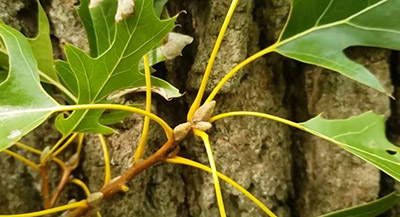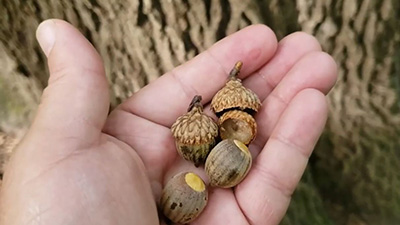Intro to Trees of Indiana: Black Oak
The classic and trusted book "Fifty Common Trees of Indiana" by T.E. Shaw was published in 1956 as a user-friendly guide to local species. Nearly 70 years later, the publication has been updated through a joint effort by the Purdue Department of Forestry and Natural Resources, Indiana 4-H, and the Indiana Department of Natural Resources, and reintroduced as "An Introduction to Trees of Indiana."
A printed copy of the full publication is available for purchase for $7 in the Purdue Extension Education Store. The field guide helps identify common Indiana woodlot trees. 
Each week, the Intro to Trees of Indiana web series will offer a sneak peek at one species from the book, paired with an ID That Tree video from Purdue Extension forester Lenny Farlee to help visualize each species as it stands in the woods. Threats to species health as well as also insight into the wood provided by the species, will be provided through additional resources as well as the Hardwoods of the Central Midwest exhibit of the Purdue Arboretum, if available.
This week, we take a look at the seventh of our featured oak varieties in Indiana, the Black Oak or Quercus velutina.
The leaves of black oak are multi-lobed, typically with seven lobes, with deep sinuses in between, and have bristle tips like all members of the red/black oak family. On the black oak, the alternately held leaves can be extremely variable in shape, but the tops of the leaves are dark and shiny and have a leathery appearance. Leaves change from dark green in summer to yellow or yellow brown in fall.
One key characteristic of black oak are the terminal buds, which are angular and fuzzy, very large and light tan. Alternately, the cluster of terminal buds at the end of northern red oak stems are smooth, shiny and reddish brown to brown in color.
The bark is very dark in color with narrow, blocky ridges, and lacks the silvery running ridges that are found on northern red oak.
The fruit is a small rounded acorn with striping running up and down the sides and a fuzzy coating along the outside edge. The cap is deeper than northern red oak and the scales on the edge of the cap resemble loose, rough shingles.
 Black oaks, which grow to 50 to 60 feet tall, are found mostly in dry, upland areas. The natural range of the black oak is nearly all of the eastern United States, from Nebraska, Iowa and Oklahoma to the west, dipping south into Texas, Louisiana, Mississippi, Alabama, Georgia and even a bit of the panhandle of Florida, extending along the eastern coastline, and northward into southern Ontario, Canada.
Black oaks, which grow to 50 to 60 feet tall, are found mostly in dry, upland areas. The natural range of the black oak is nearly all of the eastern United States, from Nebraska, Iowa and Oklahoma to the west, dipping south into Texas, Louisiana, Mississippi, Alabama, Georgia and even a bit of the panhandle of Florida, extending along the eastern coastline, and northward into southern Ontario, Canada.
The Morton Arboretum states that black oak has a high tolerance of alkaline soils and dry sites, although it prefers acidic and dry soil. This species cannot withstand severe drought. It can also be difficult to transplant due to a deep taproot.
As with other oaks, the black oak should be pruned in the dormant season to avoid attracting beetles that may carry oak wilt, which can be a potential disease problem. Galls on leaves caused by mites or insects are common, but not harmful.
According to the Hardwood Lumber and Veneer Series, red oak, which can contain as many as 17 different species of trees including black oak, constitutes about one third of all the hardwood lumber produced, with northern red oak as the most preferred species. Black oak is the second most common species in the Midwestern region, but is often found on poorer sites than northern red oak, and in this case, the lumber quality is less than that of northern red oak.
In general, red oak lumber has a very characteristic, showy, coarse grain pattern. Wood color can range from a vary light pink to a blood red color. Red oak is rated as the best wood to plane and second best in boring. It also receives high marks for shaping, turning and steam bending.
Lumber from the red oak group weighs around 44 pounds per cubic foot, making it one of our heavier woods. It is also one of our strongest woods. Red oak lumber has been used for a variety of purposes from furniture and cabinets to millwork, caskets and hardwood flooring.
Other Resources:
ID That Tree: Black Oak
ID That Tree: Red Oak Group
Hardwood Lumber and Veneer Series: Red Oak Group
Morton Arboretum: Black Oak
Purdue Plant Doctor
Native Trees of the Midwest, The Education Store
Shrubs and Woody Vines of Indiana and the Midwest, The Education Store
Investing in Indiana Woodlands, The Education Store
Forest Improvement Handbook, The Education Store
ID That Tree, Purdue Extension-Forestry & Natural Resources (FNR) YouTube playlist
Woodland Management Moment , Purdue Extension-FNR YouTube playlist






